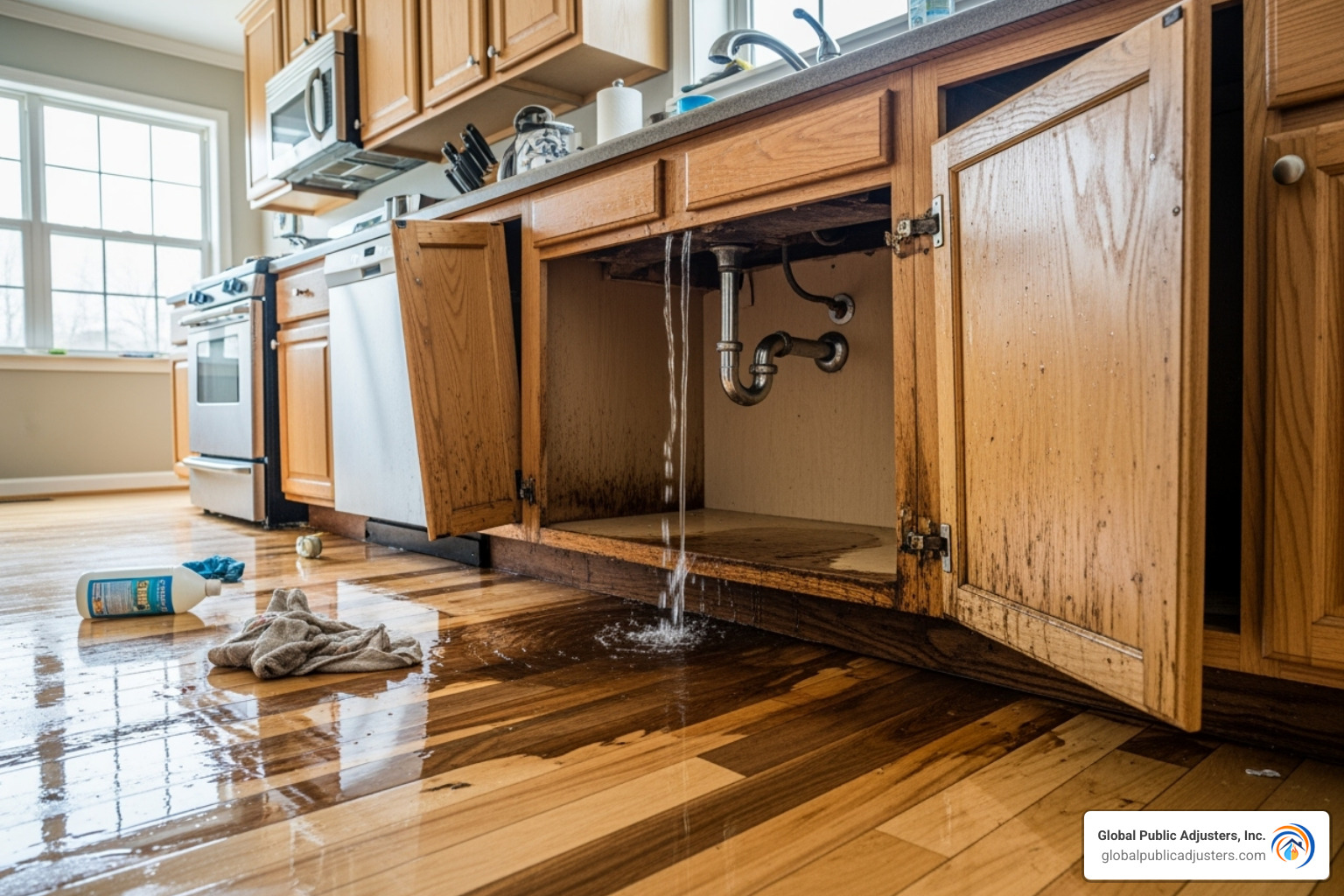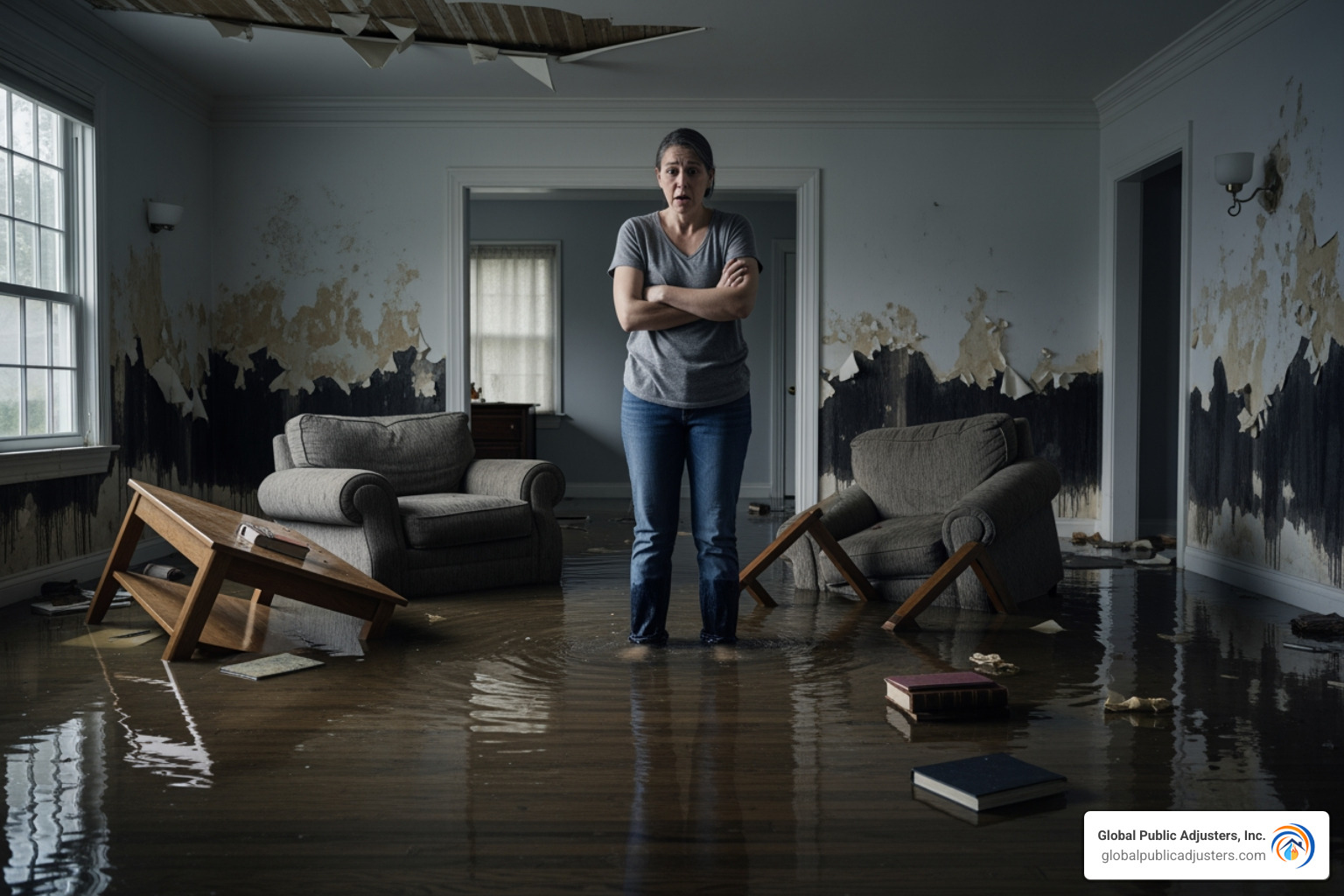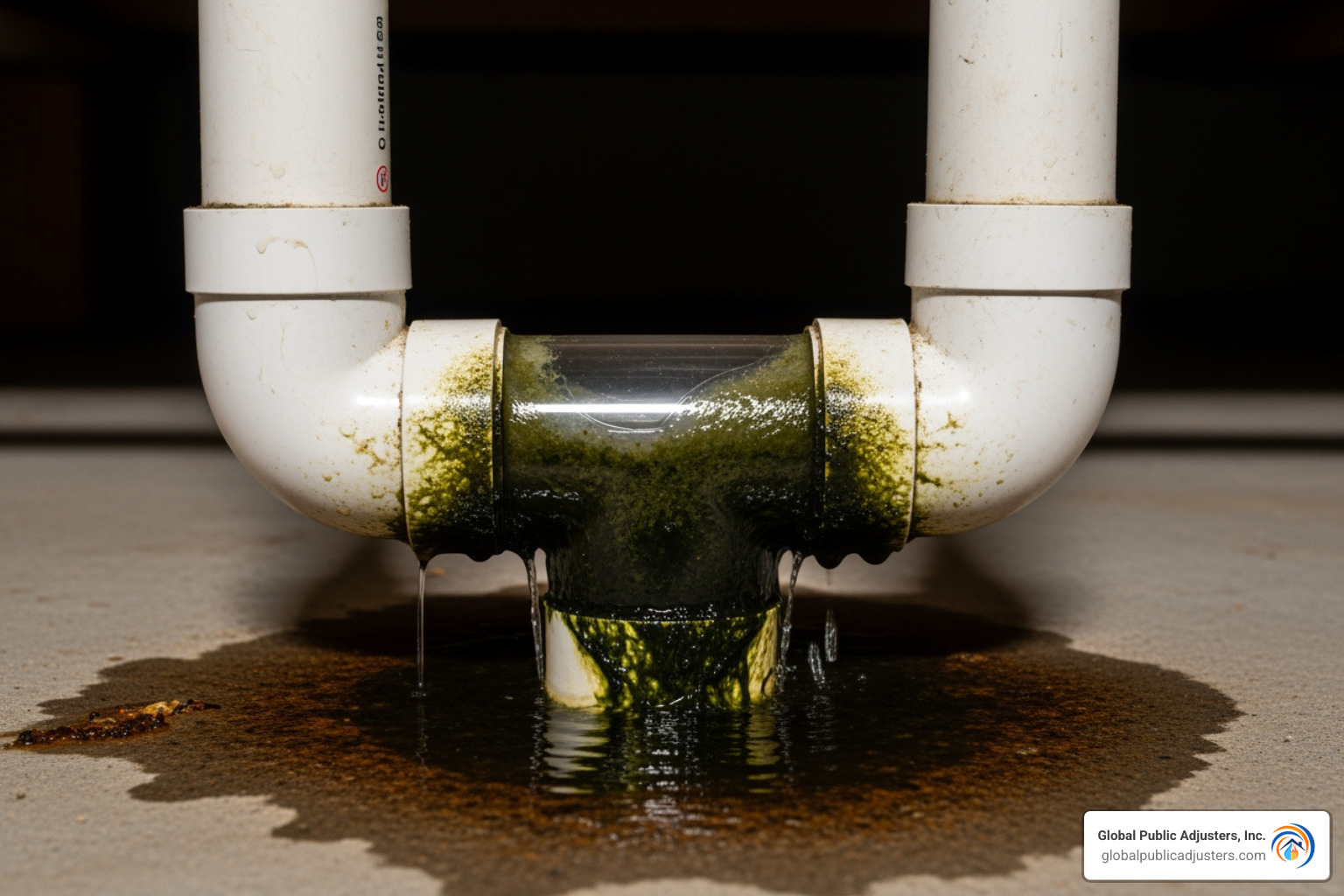Kitchen water damage repair: 5 Quick Fixes
Why Kitchen Water Damage Repair Can’t Wait
Kitchen water damage repairis one of the most urgent home emergencies you’ll face. Whether it’s from a burst pipe, leaking dishwasher, or overflowing sink, water damage spreads fast and gets expensive quickly.
Quick Action Steps for Kitchen Water Damage:
- Turn off water source– Find the shutoff valve or main water line
- Cut electricity– Switch off circuit breakers to affected areas
- Remove standing water– Use shop vacs, towels, or mops
- Document everything– Take photos and videos for insurance
- Call professionals– For extensive damage or contaminated water
- Start drying immediately– Use fans and dehumidifiers within 24-48 hours
Water damage is the most common and costly disaster homeowners face, costing billions of dollars annually. A burst pipe alone can cause an estimated $5,000 in damages, while even a small dishwasher leak can lead to thousands in repair costs.
The kitchen is particularly vulnerable because it houses multiple water sources – sinks, dishwashers, refrigerators with ice makers, and complex plumbing. When these fail, water doesn’t just damage your cabinets and floors. It travels into walls, under subflooring, and into adjacent rooms.
Time is critical.Mold can begin growing in as little as 24-48 hours if areas stay wet. What starts as a simple leak can become a major restoration project affecting your home’s structure and your family’s health.
The repair process involves three key phases: stopping the damage (mitigation), cleaning and sanitizing (remediation), and rebuilding (restoration). Understanding these steps – and knowing when to handle repairs yourself versus calling professionals – can save you thousands of dollars and weeks of disruption.
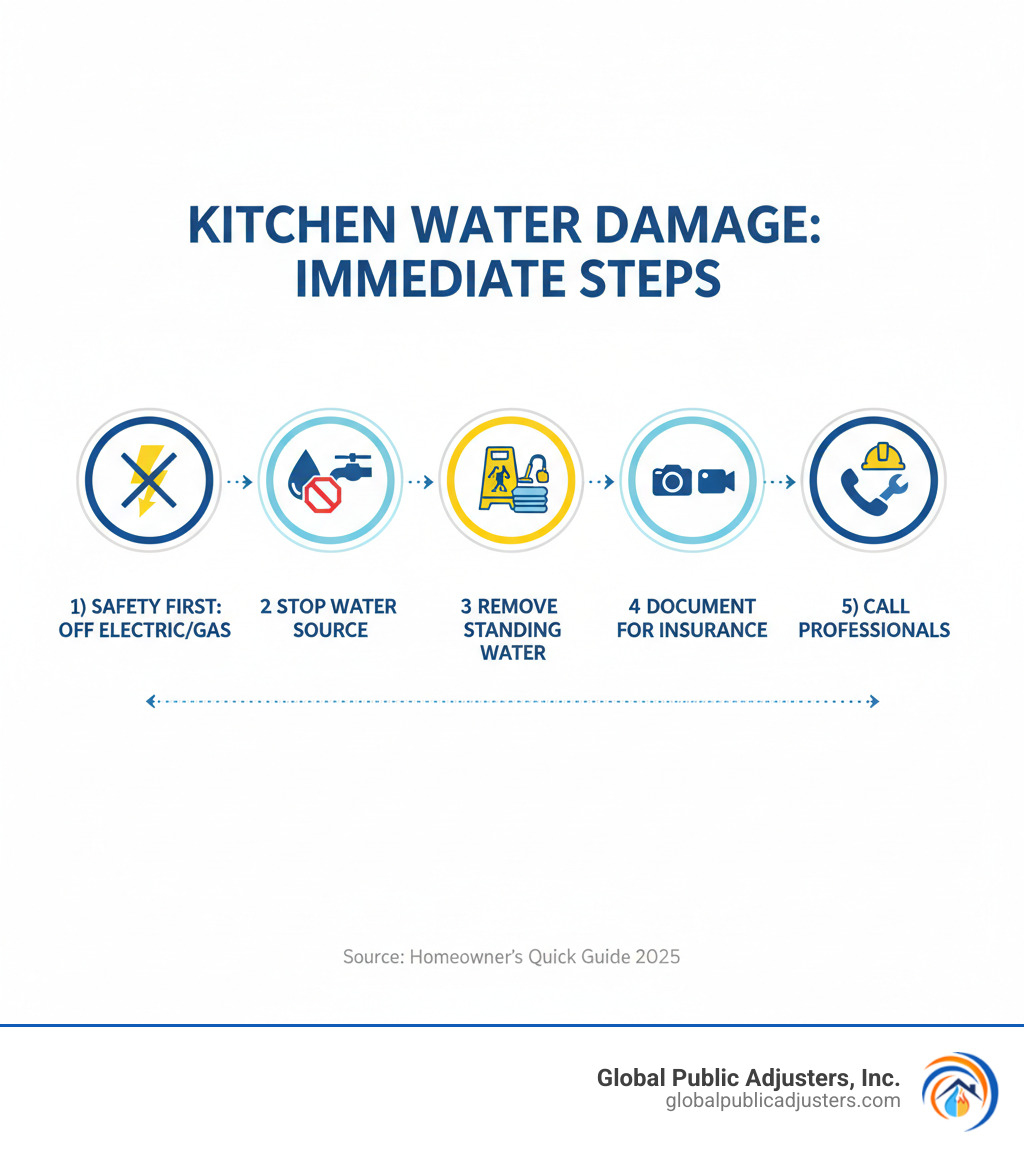
First Response: What to Do Immediately After Finding Water Damage
Walking into your kitchen and finding water everywhere can make your heart sink. Whether it’s from a burst pipe under the sink or your dishwasher deciding to flood the floor, your first instinct might be to panic. Take a deep breath.Acting quickly and safely can save you thousands of dollarsand prevent a small problem from becoming a major disaster.
Safety always comes first.Water and electricity are a dangerous combination, so before you do anything else, turn off the power to the affected area at your circuit breaker. If there’s standing water near outlets or electrical appliances, don’t take any chances. When in doubt, call an electrician.
Next, you need tostop the water at its source.This might mean shutting off the valve under your sink, disconnecting your dishwasher’s water supply, or in severe cases, turning off your home’s main water valve. Here’s a pro tip: if you don’t know where your main water shutoff is located, find it now and mark it clearly. You’ll thank yourself later when you’re dealing with an emergency at 2 AM.
If you have gas appliances that might be affected, proceed with extra caution. A submerged gas line is serious business. Turn off your home’s gas supply if you suspect any damage, or call your gas provider immediately.
Once you’ve handled the safety concerns, it’s time tostart removing standing water.For smaller amounts, towels and mops work fine. But for bigger floods, a wet/dry vacuum (shop vac) is your best friend. You can rent one if you don’t own one. Work quickly but safely, wearing rubber boots, gloves, and protective clothing.
Open cabinet doors and drawersto let air circulate. Move valuable items and anything you can save to a dry area. The faster you get things dried out, the better your chances of avoiding mold and further damage.
For comprehensive safety guidelines, FEMA provides excellent advice onsafely cleaning up after a flood.
Document Everything for Your Claim
Here’s where many homeowners make a costly mistake: they start cleaning up before documenting the damage.Don’t touch anything until you’ve taken photos and videos of everything.Your insurance company will need this evidence to process your claim properly.
Take wide shots of your entire kitchento show the scope of the damage. Then get close-up photos of specific problems like swollen cabinet doors, warped flooring, or water stains on walls. If you can see what caused the flooding, photograph that too.
Create a written inventoryof every damaged item. Include details like when you bought it, how much it cost, and its current condition. This might seem tedious when you’re stressed, but it’s crucial for your insurance claim.
Save every receiptfor emergency supplies, temporary repairs, and anything else you buy during cleanup. These expenses are often reimbursable through your insurance policy.
This documentation will be invaluable when working with your insurance company. For more details on what to expect during the claims process, check out our guide on thehomeowners claim process.
Assess the Water Source and Type
Not all water damage is created equal. The type of water flooding your kitchen determines how dangerous the cleanup is and whatkitchen water damage repairmethods you’ll need.
The restoration industry follows standards set by the Institute of Inspection, Cleaning and Restoration Certification (IICRC), which categorizes water into three types:
| Category | Description |
|---|---|
| Clean Water (Category 1) | Comes from sanitary sources like burst supply lines, overflowing sinks, or appliance malfunctions. While not immediately dangerous, it can quickly become contaminated if left untreated. |
| Gray Water (Category 2) | Contains some contamination from sources like dishwasher discharge, washing machine overflow, or toilet overflow with urine only. Can cause illness if consumed and requires more careful cleanup. |
| Black Water (Category 3) | Heavily contaminated water from sewage backups, toilet overflows with feces, or flood water. Poses serious health risks and requires professional remediation. |
Category 1 water might seem harmless, but it can quickly degrade to Category 2 or 3 if it sits too long or picks up contaminants from your home.Category 2 and 3 water require special safety precautionsduring cleanup and often need professional restoration services.
Understanding these categories isn’t just about safety – it also affects your insurance coverage and claim process. Insurance companies treat different water categories differently, so proper identification is crucial for your claim.
For a deeper understanding of how different water sources affect your home and insurance claim, explore our resource onsome different types of water damage.
The Complete Guide to Kitchen Water Damage Repair
This section covers the full process from initial drying to final repairs, helping you understand both DIY and professional approaches.
DIY Steps for Minor Kitchen Water Damage Repair
When you’re dealing withminor kitchen water damage repairfrom clean water sources, there are several steps you can take yourself. The key word here is “minor” – we’re talking about small leaks that haven’t spread far or sat for long periods.
Your first priority is getting everything completely dry. After you’ve removed the standing water, it’s time to bring in the heavy artillery:fans and dehumidifiers. Position fans so they blow directly onto wet areas, and don’t forget to open all cabinet doors and drawers. Air needs to circulate everywhere, especially inside those enclosed spaces where mold loves to hide.
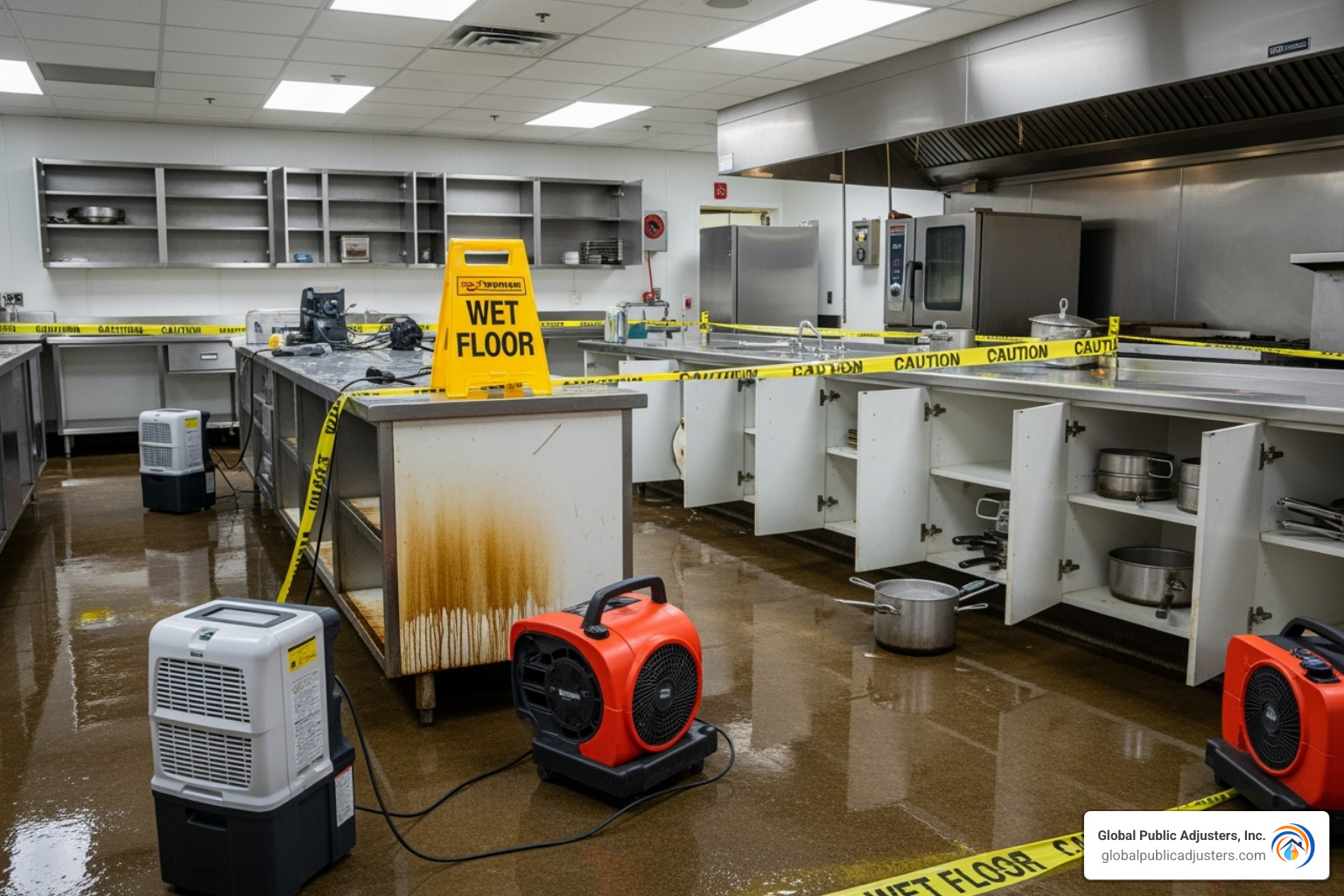
Here’s something many homeowners don’t realize:mold can start growing in just 24-48 hours. That’s why speed matters so much. If you have a moisture meter (you can rent one from most home improvement stores), use it to check that areas are truly dry, not just dry on the surface.
Once everything is bone dry, it’s time for thecleaning and sanitizing phase. Start with basic cleaning using water and detergent, then follow up with a disinfectant. The EPA has a great point about this – disinfectants don’t work well if you haven’t cleaned up the dirt first. For detailed guidance on safe cleaning practices, check out theEPA cleaning guidelines.
Now comes the repair work. Forcabinet surfacesthat have minor damage, you might be able to sand down discolored or slightly swollen areas and apply fresh varnish or paint. Sometimes warped cabinet doors can be saved with wood glue and clamps, though this works better on solid wood than composite materials.
Minor drywall repairis also possible if the damage is less than 3/8 inch of swelling and the area is completely dry and mold-free. You can cut out the damaged section, patch it with new drywall, and repaint. Just remember – if you see any signs of mold or if the damage seems extensive, it’s time to call in the professionals.
When to Call a Professional for Kitchen Water Damage Repair
While DIY efforts can handle small problems, there are clear warning signs thatprofessional kitchen water damage repairis absolutely necessary. Trying to handle these situations yourself isn’t just ineffective – it can be dangerous.
Extensive floodingis the most obvious indicator. If water has seeped into walls, gotten under flooring, or affected multiple cabinets, you need professional equipment and expertise. We’re talking about industrial-grade water extractors, commercial dehumidifiers, and specialized drying techniques that most homeowners simply don’t have access to.
Black water contaminationis a definite no-go for DIY repairs. Remember our earlier discussion about Category 3 water? This stuff is seriously hazardous to your health. Don’t even think about cleaning it yourself – call certified professionals immediately.
Mold growth signsare another red flag. If you see those telltale black or green spots, or if there’s a musty smell that wasn’t there before, mold has already taken hold. Mold spreads quickly and can affect your family’s health, especially if anyone has allergies or respiratory issues.
Structural damagelike warped subfloors, buckling walls, or any damage to supporting structures requires professional assessment. Your home’s safety depends on these structural elements being properly repaired.
Electrical system concernsare particularly serious. Water and electricity are a deadly combination. If any outlets, wiring, or electrical appliances have been affected, you need licensed electricians and water damage professionals working together.
Look forIICRC-certified professionalswho have specialized training in water damage restoration and mold remediation. They can spot hidden problems that untrained eyes might miss. If you’re in our service area, we work with trusted partners who provideWater Restoration Services Orlando.
Understanding the Professional Restoration Process
Professionalkitchen water damage repairisn’t just about mopping up water and setting up a few fans. It’s a comprehensive, three-phase process that ensures your kitchen is safely restored to its original condition – or sometimes even better than before.
Mitigationis the emergency response phase. Professionals arrive with powerful pumps and industrial wet/dry vacuums to extract standing water quickly. Then comes the serious drying equipment:high-speed air moversthat can move thousands of cubic feet of air per minute, andcommercial dehumidifiers(both desiccant and LGR types) that pull moisture from the air and materials much more effectively than household units.
The speed of this phase is critical. Every hour that passes increases the risk of mold growth and structural damage. Professional teams work around the clock during this phase because they understand that time is literally money – and health.
Remediationbegins once everything is properly dried. This phase involves thorough cleaning, sanitizing, and deodorizing of salvageable materials. Professionals usespecialized cleaning agentsand techniques that go far beyond what’s available to homeowners. They also have tools likemoisture meters and thermal imaging camerasthat can detect hidden moisture pockets in walls, floors, and ceilings.
This is where their training really shows. They know exactly where water likes to hide and how to find it before it becomes a bigger problem. If mold is present, remediation includes containment procedures, air filtration, and safe removal of contaminated materials.
Restorationis the final rebuilding phase. This is where your kitchen gets put back together, often with improvements over the original. Severely damaged kitchen cabinets might need complete replacement, especially if they’re made of particleboard or MDF that swells beyond repair when wet.
Professional restoration ensures everything meets current safety standards and building codes. Sometimes this means your kitchen ends up better than it was before the damage occurred – a silver lining to an otherwise stressful situation.
Water damage affects homes in ways that aren’t always immediately visible. UnderstandingHow Can Water Damage My Homehelps you appreciate why professional restoration is so thorough and why cutting corners during repairs often leads to bigger problems down the road.
Navigating Your Insurance Claim for Kitchen Damage
Filing an insurance claim can be as challenging as the repair itself. Understanding the process is key to getting the settlement you deserve.
When water wreaks havoc in your kitchen, dealing with the insurance claim process often feels like adding insult to injury. You’re already stressed about the damage, and now you have to steer complex policies and procedures. The good news? Understanding what’s covered and having the right advocate on your side can make all the difference in getting the settlement you deserve.
What Does Homeowners Insurance Cover?
Most homeowners insurance policies coverkitchen water damage repairwhen the damage issudden and accidental. This is the golden phrase that determines whether your claim gets approved or denied.
Your policy typically covers damage fromburst pipes– those unexpected ruptures in supply lines that can flood your kitchen in minutes.Appliance malfunctionsare usually covered too, like when your dishwasher hose fails or your refrigerator’s ice maker starts leaking.Overflowing fixturesfrom sudden blockages also fall under coverage, as does water damage from firefighting efforts if you’ve had a kitchen fire.
But here’s where things get tricky. Insurance companies are quick to deny claims for what they consider preventable damage.Gradual leaksthat develop slowly over time typically aren’t covered – the reasoning being that you should have noticed and fixed that persistent drip before it caused major damage.Lack of maintenanceis another common exclusion. If your old, corroded pipes finally give out, insurers might argue you should have replaced them earlier.
Flooding from natural disastersrequires separate flood insurance – your standard policy won’t cover river overflows or storm surges that come up from the ground.Sewer and drain backupsare often excluded too, though you can usually add this coverage for an additional premium.
Insurance companies have entire departments dedicated to finding reasons to deny claims or reduce payouts. That’s why understanding these distinctions upfront can save you months of frustration. We’ve seen all theReasons Why Your Property Insurance Claim Can Be Denied, and we know how to present your claim to avoid these pitfalls.
The Role of a Public Adjuster
When you file a claim, your insurance company will send their own adjuster to assess the damage. Here’s what many homeowners don’t realize: that adjuster works for the insurance company, not for you. Their job is to protect the insurer’s bottom line, which often means finding ways to minimize what they pay out.
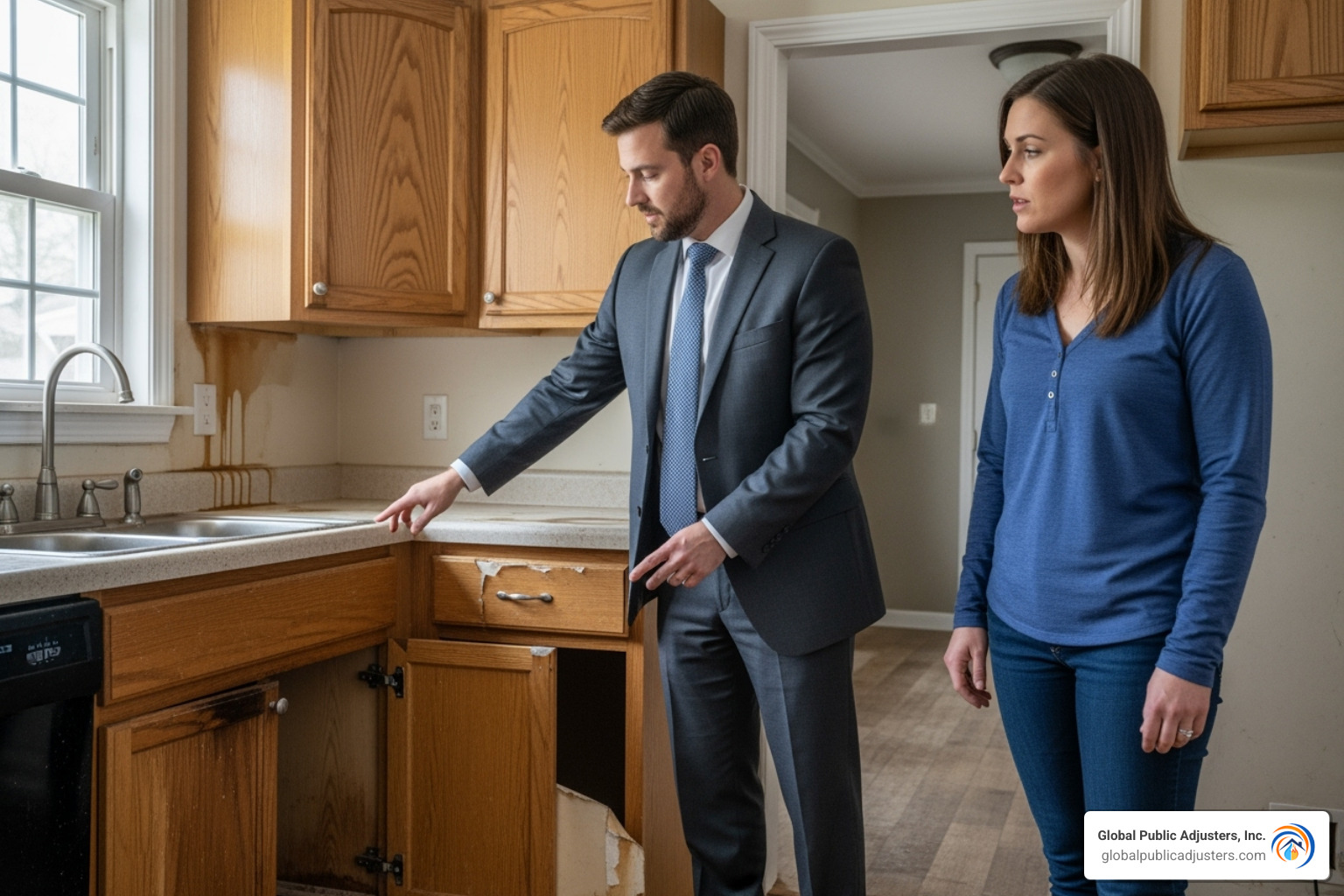
That’s where we come in. As public adjusters at Global Public Adjusters, we’reyour advocates. We work exclusively for you, conducting our own thorough damage assessment and preparing a detailed claim designed to maximize your settlement. We know insurance policies inside and out, and we speak the language that gets results.
One area where we frequently fight for homeowners iscabinet matching. Insurance companies love to play the “we’ll only pay for the damaged cabinets” game. But here’s the reality: if your 10-year-old kitchen cabinets can’t be perfectly matched with new ones (and they rarely can), your policy likely requires the insurer to replace all the cabinets to maintain uniformity. We don’t let them get away with leaving you with a patchwork kitchen that looks like it was assembled from spare parts.
Negotiating repairsis another area where having professional representation pays off. Insurance companies might offer to cover basic repairs when your policy actually entitles you to full restoration. We ensure every damaged component is accounted for and that the repair quality meets professional standards.
With over 50 years of combined experience, we understand the tactics insurance companies use to underpay claims. We document everything carefully, present compelling evidence, and negotiate aggressively on your behalf. Our track record speaks for itself – we consistently secure higher settlements than homeowners achieve on their own.
For more insight into how professional representation can benefit your claim, explore theReasons to Hire a Public Adjuster for Property Damage. When you’re dealing withkitchen water damage repair, having someone in your corner who knows the system can mean the difference between a fair settlement and a financial disappointment.
Preventing Future Kitchen Water Disasters
While we’re here to help when disaster strikes, prevention is always the best strategy.Proactive maintenance is the best defense against future kitchen water damage repairneeds. Think of it like going to the dentist – a little prevention now saves you from major problems later.
Kitchen Maintenance Checklist
The good news is that most water disasters are completely preventable with regular attention to a few key areas. We’ve seen countless homeowners avoid major headaches by staying on top of these simple maintenance tasks.
Inspect your appliance hoses regularly.Those rubber hoses behind your dishwasher, refrigerator ice maker, and washing machine are ticking time bombs if left unchecked. Look for cracks, bulges, or any signs of wear every few months. Pro tip: replace standard rubber hoses with braided stainless steel ones – they last longer and give you peace of mind.
Make friends with the space under your kitchen sink.It’s not the most glamorous spot in your home, but checking under there monthly can save you thousands. Look for drips, water stains, or any corrosion on pipes and connections. A loose fitting today becomes a flood tomorrow.
Don’t forget your refrigerator’s drip pan.This often-overlooked component sits beneath your fridge and can overflow if it gets clogged with debris. A quick cleaning every few months prevents slow leaks that can damage your flooring.
Know where your main water shut-off valve is located– and make sure everyone in your family knows too. In an emergency, those precious minutes spent searching for the valve can mean the difference between a minor leak and major damage.
Your monthly water bill can be your early warning system.Monitor your water bills for unusual spikesthat might indicate a hidden leak somewhere in your home. Sometimes the first sign of trouble shows up in your mailbox, not on your floor.
Regular appliance maintenance following manufacturer guidelines keeps everything running smoothly. Check your dishwasher’s door seals, inspect connections, and address any small issues before they become big problems.
If you live in a colder climate,insulate pipes that run through unheated areasto prevent freezing and bursting. And consider investing in a water leak detection system with automatic shutoff features – technology that can literally save your home while you’re sleeping or away.
Long-Term Consequences of Improper Repairs
We’ve seen too many homeowners try to cut corners after water damage, thinking they can save money with quick fixes. Unfortunately, improperkitchen water damage repairoften costs far more in the long run than doing it right the first time.
Chronic mold issuesare the most common consequence of rushed repairs. If moisture isn’t completely removed from walls, cabinets, or subflooring, mold will return with a vengeance. This isn’t just about unsightly spots – we’re talking about persistent musty odors and potential health problems for your family.
The health risks extend beyond mold. Improperly cleaned contaminated water leaves behind bacteria and pathogens that create an unhealthy living environment. Your kitchen should be the heart of your home, not a source of illness.
Structural integrity becomes compromisedwhen water damage isn’t properly addressed. Water weakens wooden beams, causes subflooring to rot, and damages drywall in ways that aren’t always immediately visible. What looks like a cosmetic fix on the surface can hide serious structural problems underneath.
Your home’s value takes a hit too. Potential buyers are incredibly wary of properties with a history of water damage, especially if the repairs look questionable. A thorough, professional restoration actually protects your investment.
Those lingering odors that some homeowners learn to live with? They’re not just unpleasant – they’re a sign that moisture problems persist. That “wet basement” smell in your kitchen indicates ongoing issues that will only get worse with time.
The reality is that cutting corners on water damage repair means you’re simply postponing a bigger, more expensive problem. We regularly help homeowners who initially tried DIY repairs, only to face extensive mold remediation or structural repairs months later. For insights into what to watch for, check outSome Signs of Water Damage in Your Home.
Investing in proper restoration from the start isn’t just about fixing today’s problem – it’s about protecting your family’s health, your home’s value, and your future peace of mind.
Conclusion
Kitchen water damage repairdoesn’t have to overwhelm you, even though finding water pooling around your cabinets or appliances can feel like a nightmare. The key is knowing what to do and acting quickly.
Your safety comes first– always turn off electricity to affected areas and stop the water source before anything else. Then move fast to remove standing water and start the drying process. Every hour counts when it comes to preventing mold growth and further damage.
Document everything thoroughlywith photos and videos before you start cleaning up. This documentation becomes your lifeline when dealing with insurance companies. Understanding whether you’re dealing with clean water, gray water, or black water helps you make the right decisions about safety and cleanup approaches.
Minor water damagefrom clean sources might be something you can handle yourself with fans, dehumidifiers, and some elbow grease. But don’t try to be a hero when facing extensive flooding, contaminated water, or signs of mold growth. Professional restoration teams have industrial-grade equipment and specialized training that can save you time, money, and health risks in the long run.
Insurance claims can be tricky territory.Your insurance company’s adjuster works for them, not you. That’s where we come in. With over 50 years of experience helping homeowners steer these challenging situations, we understand how to present your claim to maximize your settlement. We’ve seen too many families settle for less than they deserved simply because they didn’t know their rights.
Prevention really is worth a pound of cure.Check those appliance hoses regularly, know where your main water shutoff valve is located, and keep an eye on your water bills for unusual spikes. Small maintenance tasks now can prevent major headaches later.
The long-term consequences of cutting corners during repairs aren’t worth the risk. Chronic mold issues, structural damage, and decreased property value are expensive problems that proper restoration prevents. Your family’s health and your home’s integrity are too important to gamble with.
For help navigating the complexities of your insurance claim and ensuring you get a fair settlement for yourKitchen Damage Claims in Orlando, our team is here to help. We fight for homeowners every day, and we’d be honored to fight for you too.

